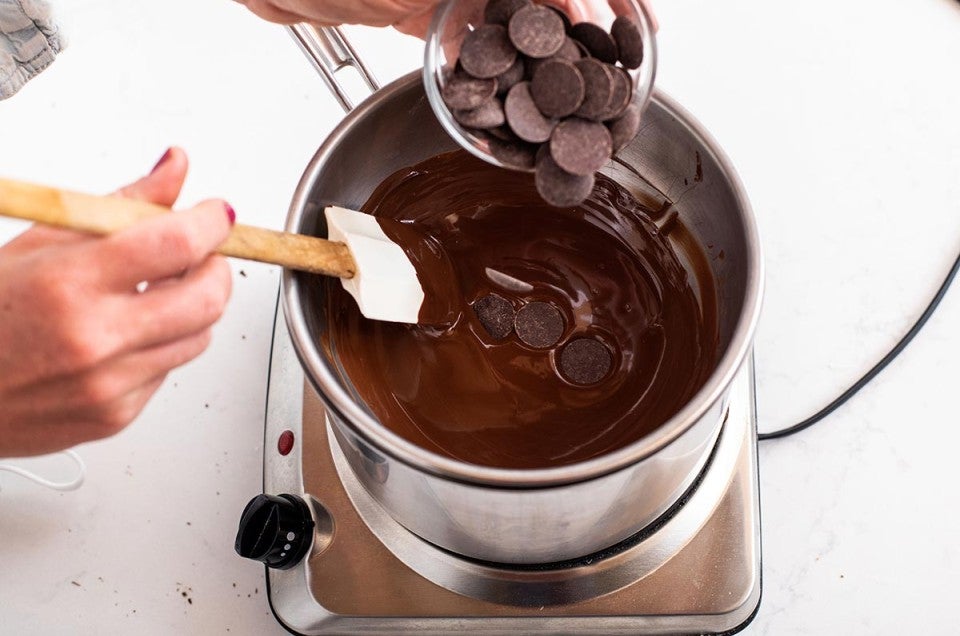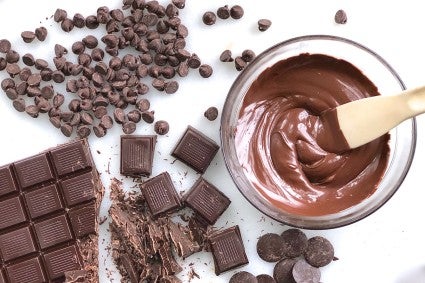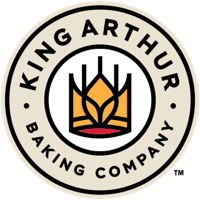Things bakers know: Yes, you can mix chocolate and water (!)
Myth-busting, one drop of water at a time.


If you’ve ever dripped a bit of water into a bowl of melted chocolate, you know what happens next: The silky mixture suddenly seizes up, becoming a thick, grainy mass, and no amount of whisking will restore it to its satiny glory. That’s because chocolate and water don’t mix, right? Well, yes and no.

First, a bit of science. Chocolate is comprised of three main ingredients: cacao bean solids, sugar, and cocoa butter, which you can think of as the glue that holds the solids and sugar together. Notably, chocolate doesn’t contain any water. So when a bit of water (or another liquid, such as heavy cream, milk, vanilla extract, or liqueur) is added to melted chocolate, all of the water-soluble compounds in the cacao solids, plus the hygroscopic, water-loving sugar crystals, rush to greet it. As the sugar crystals and cocoa particles pull away from the cocoa butter, the emulsion in the chocolate breaks, causing the chocolate to separate, resulting in the chunky disaster we’re all too familiar with.
But here’s the twist: If you add enough water (or other liquid) to the melted chocolate, the mixture will become smooth and silky once again. The cacao bean solids and sugar crystals are no longer pulling away from the cocoa butter like angry teenagers; instead, they’re floating in suspension alongside tiny droplets of water and cocoa butter.
In our Test Kitchen, we conducted an experiment, melting 2 ounces (57g) of 62% chocolate, then adding cool tap water, drop-by-drop, stirring it into the melted chocolate. After each drop, the chocolate thickened slightly. By the time we’d added 5 drops, the chocolate had thickened enough that it could be used for piping a message onto a cake or a design on a plate. Any more than 5 drops, though — as little as 1/2 teaspoon — and the chocolate began to seize, at first appearing greasy, then solidifying into a thick paste. Ugh! But if we kept adding water to the seized mess, something magical happened; the chocolate re-emulsified, becoming smooth and silky once again.

In her fantastic book Bakewise, author Shirley Corriher explains that chocolates of different percentages require different amounts of water to prevent seizing. For chocolate that is 55% to 60% (meaning that 55% to 60% of what is in that bar comes from the cocoa bean as chocolate liquor and added cocoa butter), like bittersweet and semisweet, the minimum amount of water-type liquid needed to prevent seizing is 1 tablespoon per 2 ounces (57g) chocolate. For chocolate with a higher percentage of cacao (60% to 70%), you need to add more liquid: 1 1/2 tablespoons to 2 ounces (57g) chocolate. And unsweetened chocolate requires yet more water or water-type liquid to prevent seizing: 2 tablespoons per 2 ounces (57g) chocolate. You can add more, of course, but if you add any less the chocolate is likely going to seize; that’s why an errant splash of water (or the steam from a double boiler) into your bowl of melted chocolate can spell trouble.
This is useful information, for a few reasons: One, there are times that you want to thicken your chocolate just slightly, for piping a message on a cake, or a design on top of a chocolate bonbon, for example. In this case, a few drops of water (and no more!) thickens without seizing. It’s also very useful to know that it’s possible to save seized chocolate, simply by whisking in more cool water little by little until it smooths out. You can’t use this thinned out chocolate for everything (it won’t work, for example, for tempering), but it’s perfectly suitable for icings or fillings. Or, you can let your seized chocolate cool (it will harden) then chop it up and add it to cookie dough. And while you can save seized chocolate, the best defense is a good offense: preventing your chocolate from seizing in first place by eschewing the water bath chocolate melting method in favor of the water-free, King Arthur-approved best method for melting chocolate: in the microwave.
And lastly, there may be times that you want to make a wonderful silky dairy-free ganache or chocolate mousse. French chemist Hervé This cracked the code for a water mousse (you can see his method here); if you use a chocolate that doesn’t contain any milk solids, it’s also vegan. What’s more, a mousse or ganache made with water, rather than cream (and eggs, in the case of mousse), is a wonderful way to highlight the flavor of good chocolate.
Armed with this information, you can go out and seize the day (not the chocolate).
We've got the best chocolate for baking, and the best chocolate recipes, too!
Cover photo by Jenn Bakos.

